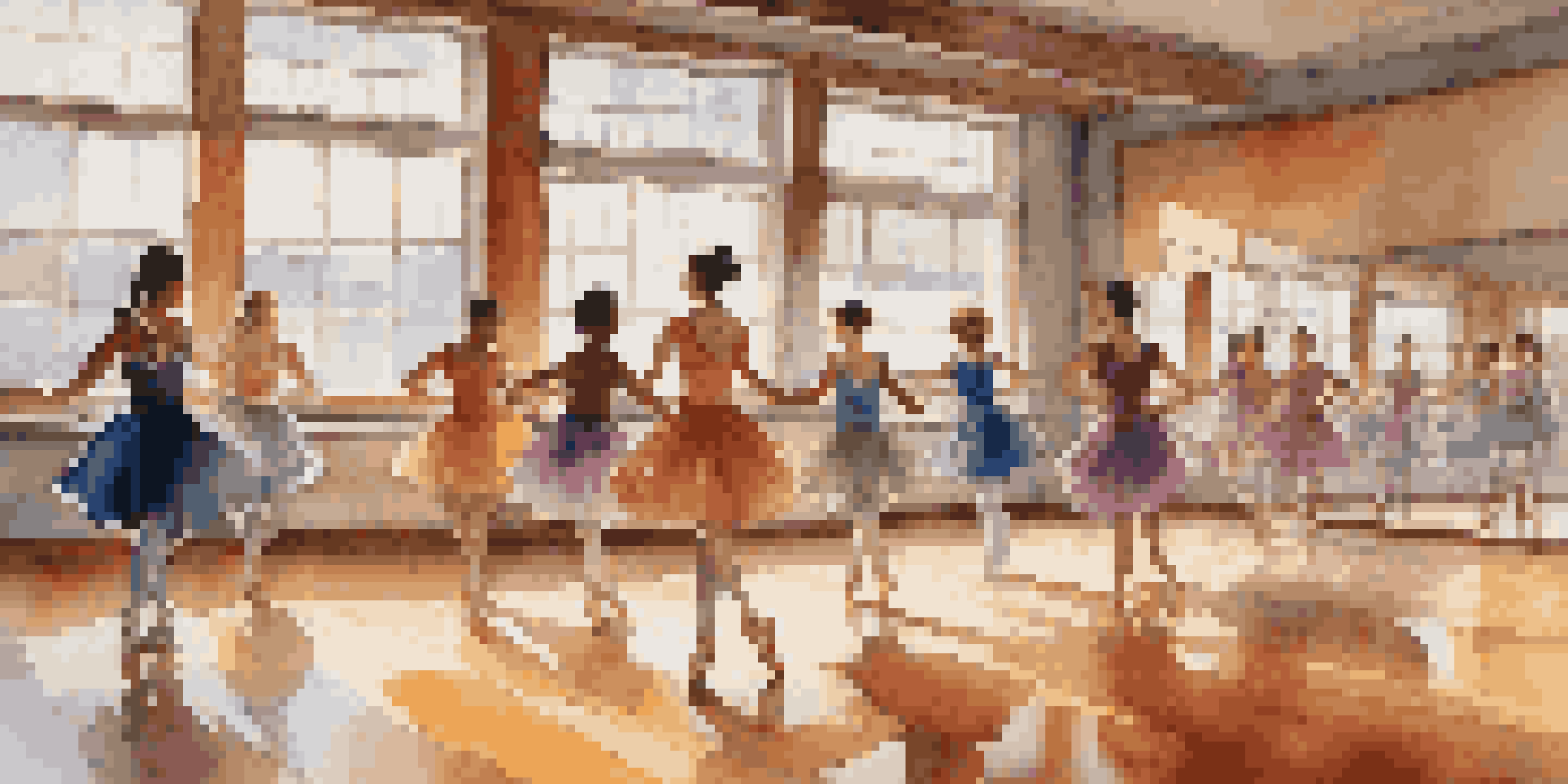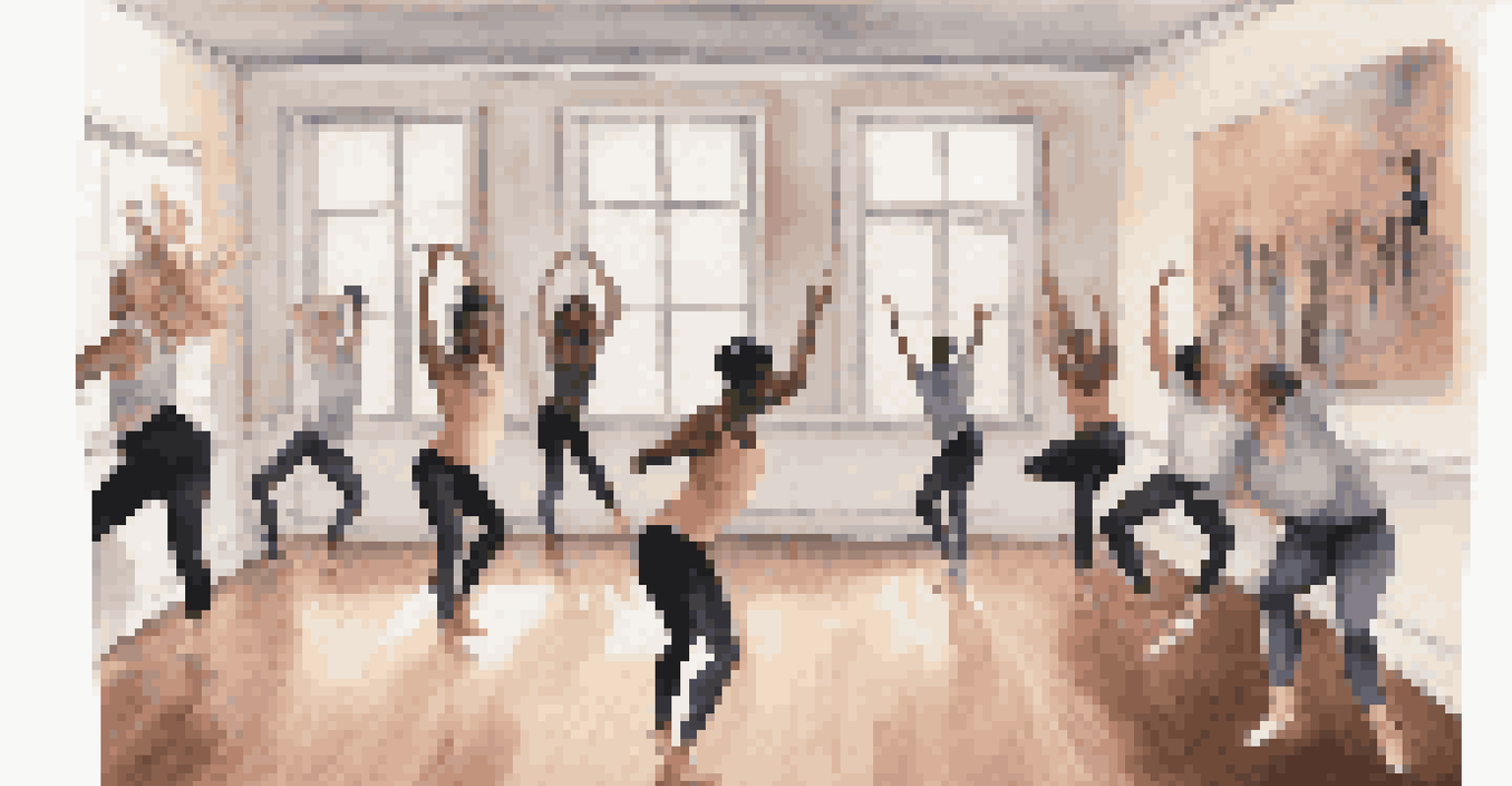Dance Education: The Shift to Online Platforms Post-Pandemic

The Impact of the Pandemic on Dance Education
The COVID-19 pandemic dramatically changed the landscape of dance education. With studios closing and in-person classes halted, educators had to think outside the box. Many turned to online platforms, discovering new ways to connect with students, although challenges arose in maintaining the essence of dance.
Dance is the hidden language of the soul.
Despite the initial hurdles, dancers and instructors adapted quickly. Zoom classes became the new norm, allowing students to continue learning from the safety of their homes. This shift opened doors for diverse teaching methods and access to resources that were previously unavailable.
As restrictions eased, the question arose: would dance education return to traditional settings, or has the online model become a permanent fixture? The answer lies in the blending of both worlds, creating a hybrid approach that caters to a broader audience.
Benefits of Online Dance Education
Online dance education offers a plethora of benefits that can enhance the learning experience. Firstly, students can access classes from anywhere, breaking geographical barriers that previously limited participation. This flexibility allows dancers to explore various styles and instructors without the constraints of travel.

Additionally, the use of technology can create a more personalized learning environment. Students can record their sessions, review choreography at their own pace, and receive tailored feedback through video submissions. This aspect can significantly boost confidence, especially for beginners.
Dance Education Transformed by COVID
The pandemic accelerated the shift to online dance education, prompting innovative teaching methods and a blend of virtual and in-person classes.
Moreover, online platforms facilitate community building in unique ways. Virtual classes often draw a diverse group of participants, fostering a sense of belonging among dancers from different backgrounds and experiences, which enriches the learning process.
Challenges Faced in Online Dance Learning
While the shift to online platforms has its advantages, it also comes with significant challenges. One major issue is the lack of physical interaction, which is crucial in dance education. Dancers often benefit from immediate feedback and hands-on corrections that are difficult to replicate through a screen.
The only way to make sense out of change is to plunge into it, move with it, and join the dance.
Technical difficulties can also hinder the learning experience. Poor internet connections, software glitches, and the limitations of camera angles can prevent students from fully engaging with the class. This can lead to frustration and a diminished sense of connection to the material.
Furthermore, the online format may not suit every learning style. Some dancers thrive in structured environments, where in-person interaction and camaraderie fuel their passion. For these students, the digital shift might feel isolating and less motivating, highlighting the need for a more adaptable approach.
Innovative Teaching Methods in Online Dance Classes
Educators have embraced innovative teaching methods to enhance online dance classes. For instance, incorporating multimedia resources such as video tutorials and interactive choreography breakdowns can make learning more engaging. These tools help students visualize movements and understand techniques more deeply.
Live-streamed classes often include real-time Q&A sessions, allowing students to ask questions and receive instant feedback. This interactive element helps maintain a connection between teachers and students, fostering a sense of community despite physical distance.
Benefits of Online Learning
Online platforms enhance accessibility and personalized learning, allowing students to connect with diverse instructors and build community.
Additionally, many instructors have begun to incorporate fitness and wellness components into their dance curricula. By addressing the physical and mental aspects of dance, educators provide a holistic approach that benefits students both on and off the dance floor.
Hybrid Models: The Future of Dance Education
As we look to the future, hybrid models of dance education are emerging as a viable solution. These models combine the best of both online and in-person experiences, allowing for greater flexibility and accessibility. Students can choose between attending classes in person or participating online, tailoring their education to their individual needs.
Hybrid models also benefit instructors, as they can reach a larger audience without the limitations of physical space. This approach not only broadens their teaching opportunities but also allows for collaboration with other educators across the globe, enriching the learning experience.
Ultimately, the hybrid model encourages a more inclusive environment. Students with different circumstances—whether due to location, health, or personal preferences—can participate in the dance community, ensuring that everyone has the opportunity to express themselves creatively.
The Role of Technology in Dance Education
Technology plays a pivotal role in shaping the future of dance education. With platforms like YouTube, Instagram, and specialized dance apps, dancers can access a wealth of resources at their fingertips. This accessibility allows for self-directed learning, enabling students to explore styles and techniques that resonate with them.
Moreover, technology fosters creativity. Dancers can experiment with choreography, create their own videos, and share their work with a global audience. This not only enhances their skills but also builds confidence in their artistic expression.
Hybrid Models for Future Education
The emerging hybrid models of dance education balance online and in-person experiences, ensuring inclusivity and flexibility for all students.
As technology continues to evolve, we can expect further innovations in dance education. Virtual reality, for instance, could revolutionize how dancers practice and learn, providing immersive experiences that mimic real-life performances and competitions.
Looking Ahead: The Evolution of Dance Education
The evolution of dance education is an ongoing journey, shaped by the lessons learned during the pandemic. As we adapt to new norms, it's essential to embrace the changes while retaining the core values of dance—community, expression, and passion. The blend of online and in-person experiences will likely define the future of dance education.
Instructors and students alike must remain open to experimentation and innovation. With each new approach, there is an opportunity for growth and development that can enhance the overall dance experience. By fostering a culture of adaptability, the dance community can thrive in this new landscape.

Ultimately, the future of dance education is bright. With the right balance of technology and personal connection, we can create a nurturing environment where dancers of all ages and skill levels can flourish, ensuring that the art of dance continues to inspire and uplift for generations to come.